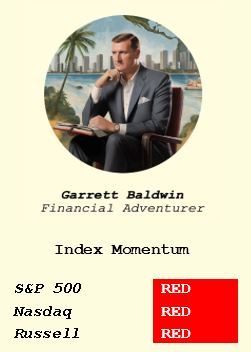
 Dear Fellow Expat,
Dear Fellow Expat,
If you’d have told me that the state with the highest total of tropical storms to start the season was California, I’d have accused you of having too much Long Drink this weekend.
But that’s the score.
California 1 – Florida 0.
I’m sure that California Governor Gavin Newsom is proud that he’s finally beating Florida in something these days.
The afternoons as we move toward September are more humid but less sweltering.
Now that my wife and daughter are at school on weekdays, it’s just me and two dogs.
And they do not like the Boom of Thunder arriving daily at 2 pm.
They follow me from room to room. They huddle and sleep. After the thunder hits, they jump and climb on me. My laptop has paw prints on the screen.
It’ll be like this for six more weeks.
Where will the market be at that time?
To be honest… who cares…
Volatility Cycle Ahead
You don’t need an MBA, a CFA, a CAIA, or 300 hours of training for the Series 7, 65, or 66 to be successful in this market…
As I’ve said – once you look at the data from 2010, focus on momentum, insider activity, and global liquidity – you will not unsee the opportunity.
For the last 12 years, central banks have pumped capital into the system, and governments and businesses have used new money to paper over previous debt.
Michael Howell has written that seven out of every eight dollars created goes to refinancing existing debt.
I expect that figure to only rise this decade. Central banks will print more money. More debt creates more debt. More money presses asset prices higher. But there is always turbulence that can arrive at any moment.
That’s why we follow three things to determine when the turbulence is about to begin.
Liquidity: Which Solomon Brothers leaders once described as the closest thing to insider information… This is money from central banks, private markets, and international money movements. We know a relationship exists between the expansion and contraction of Central Bank balance sheets and the performance of the Global MSCI Index. The chart below is Ed Yardeni’s comparison of the balance sheets of the central banks compared to the S&P 500. When we add in other forms of liquidity, the relationship is even tighter.

Insider buying: This is the summation of every executive and board member of every public company’s knowledge of today’s economic ecosystem… Insiders have very good timing when it comes to buying and selling their stocks. But when we zoom out and see the collective force of their buying and selling, we see they tend to all buy at times that align with policy shifts that fuel and push more money into the system and ultimately into risk assets like equities. They’ve bought right before every major central bank pivot over the last 13 years.

Equity momentum: which is just… measuring the inflows and outflows of the financial markets. We measure the total number of stocks in the breakout mode compared to those in the break-down mode. It produces this signal… And it tells you what to do when new conditions emerge.

How Does This Work?
We bring this all down to three colors: Green, yellow, and red.
Green, you buy.
Yellow, you hedge.
Red, you sell (or just get out of the way).
Red is what matters most to me.
I don’t want you to necessarily think about how much money you can make when momentum goes green (although it can be quite sizeable). You can see the waves of buying after each turn…
No…
I NEED YOU to think how much you will lose when momentum goes NEGATIVE and you sit around doubting what the data tells us. How much are you willing to lose by ignoring it? What if you could have gotten out of the way on March 7 of this year… or two weeks ago? Or in February 2020, before the COVID crash.
This is all about being defensive and proactive.
I’ve spent my entire life playing defense in sports for one reason: I hate to lose more than I like to win.
With a defensive mindset in this market, it ensures that we’re never the last person without a chair when the music stops.
Stay positive,
Garrett Baldwin
Secretary of Finance


